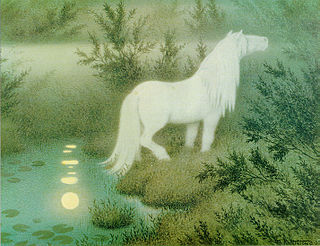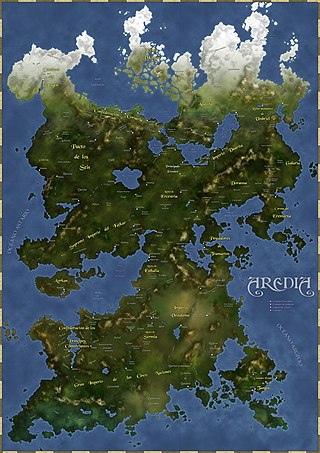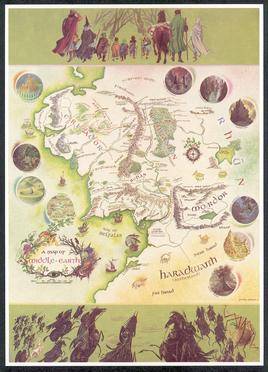High fantasy, or epic fantasy, is a subgenre of fantasy defined by the epic nature of its setting or by the epic stature of its characters, themes, or plot. High fantasy is set in an alternative, fictional ("secondary") world, rather than the "real" or "primary" world. This secondary world is usually internally consistent, but its rules differ from those of the primary world. By contrast, low fantasy is characterized by being set on Earth, the primary or real world, or a rational and familiar fictional world with the inclusion of magical elements.

Philip José Farmer was an American author known for his science fiction and fantasy novels and short stories.

A fictional universe is the internally consistent fictional setting used in a narrative work or work of art, most commonly associated with works of fantasy and science fiction. Fictional universes appear in novels, comics, films, television shows, video games, art, and other creative works.
A parallel universe, also known as an alternate universe, parallel world, parallel dimension, or alternate reality, is a hypothetical self-contained plane of existence, co-existing with one's own. The sum of all potential parallel universes that constitute reality is often called a "multiverse". While the six terms are generally synonymous and can be used interchangeably in most cases, there is sometimes an additional connotation implied with the term "alternate universe/reality" that implies that the reality is a variant of our own, with some overlap with the similarly named alternate history.

A fantasy world or fictional world is a world created for fictional media, such as literature, film or games. Typical fantasy worlds feature magical abilities. Some worlds may be a parallel world connected to Earth via magical portals or items ; an imaginary universe hidden within ours ; a fictional Earth set in the remote past or future ; an alternative version of our History ; or an entirely independent world set in another part of the universe.

A fictional country is a country that is made up for fictional stories, and does not exist in real life, or one that people believe in without proof. Sailors have always mistaken low clouds for land masses, and in later times this was given the name Dutch capes. Other fictional lands appear most commonly as settings or subjects of myth, literature, film, or video games. They may also be used for technical reasons in actual reality for use in the development of specifications, such as the fictional country of Bookland, which is used to allow European Article Number "country" codes 978 and 979 to be used for ISBNs assigned to books, and code 977 to be assigned for use for ISSN numbers on magazines and other periodicals. Also, the ISO 3166 country code "ZZ" is reserved as a fictional country code.

Lester del Rey was an American science fiction author and editor. He was the author of many books in the juvenile Winston Science Fiction series, and the editor at Del Rey Books, the fantasy and science fiction imprint of Ballantine Books, along with his fourth wife Judy-Lynn del Rey.

Malazan Book of the Fallen is a series of epic fantasy novels written by the Canadian author Steven Erikson. The series, published by Bantam Books in the U.K. and Tor Books in the U.S., consists of ten volumes, beginning with Gardens of the Moon (1999) and concluding with The Crippled God (2011). Erikson's series presents the narratives of a large cast of characters spanning thousands of years across multiple continents.
Low fantasy, or intrusion fantasy, is a subgenre of fantasy fiction in which magical events intrude on an otherwise-normal world. The term thus contrasts with high fantasy stories, which take place in fictional worlds that have their own sets of rules and physical laws.

Elements of the supernatural and the fantastic were an element of literature from its beginning. The modern genre is distinguished from tales and folklore which contain fantastic elements, first by the acknowledged fictitious nature of the work, and second by the naming of an author. Works in which the marvels were not necessarily believed, or only half-believed, such as the European romances of chivalry and the tales of the Arabian Nights, slowly evolved into works with such traits. Authors like George MacDonald (1824–1905) created the first explicitly fantastic works.
Fiction writing is the composition of non-factual prose texts. Fictional writing often is produced as a story meant to entertain or convey an author's point of view. The result of this may be a short story, novel, novella, screenplay, or drama, which are all types of fictional writing styles. Different types of authors practice fictional writing, including novelists, playwrights, short story writers, radio dramatists and screenwriters.
A setting is the time and geographic location within a narrative, either non-fiction or fiction. It is a literary element. The setting initiates the main backdrop and mood for a story. The setting can be referred to as story world or milieu to include a context beyond the immediate surroundings of the story. Elements of setting may include culture, historical period, geography, and hour. Along with the plot, character, theme, and style, setting is considered one of the fundamental components of fiction.
Worldbuilding is the process of constructing a world, originally an imaginary one, sometimes associated with a fictional universe. Developing an imaginary setting with coherent qualities such as a history, geography, and ecology is a key task for many science fiction or fantasy writers. Worldbuilding often involves the creation of geography, a backstory, flora, fauna, inhabitants, technology and often if writing speculative fiction, different peoples. This may include social customs as well as invented languages for the world.

Science fiction and fantasy in Poland dates to the late 18th century. During the latter years of the People's Republic of Poland, a very popular genre of science fiction was social science fiction. Later, many other genres gained prominence.

The Lost Continent: The Story of Atlantis (1899) is a fantasy novel by English author C. J. Cutcliffe Hyne. It is considered one of the classic fictional retellings of the story of the drowning of Atlantis, combining elements of the myth told by Plato with the earlier Greek myth concerning the survival of a universal flood and restoration of the human race by Deucalion.

Fiction is any creative work, chiefly any narrative work, portraying individuals, events, or places that are imaginary or in ways that are imaginary. Fictional portrayals are thus inconsistent with history, fact, or plausibility. In a traditional narrow sense, "fiction" refers to written narratives in prose – often referring specifically to novels, novellas, and short stories. More broadly, however, fiction encompasses imaginary narratives expressed in any medium, including not just writings but also live theatrical performances, films, television programs, radio dramas, comics, role-playing games, and video games.

Fantasy cartography,fictional map-making, or geofiction is a type of map design that visually presents an imaginary world or concept, or represents a real-world geography in a fantastic style. Fantasy cartography usually manifests from worldbuilding and often corresponds to narratives within the fantasy and science fiction genres. Stefan Ekman says that, "a [regular] map re-presents what is already there; a fictional map is often primary – to create the map means, largely, to create the world of the map."

"A Map of Middle-earth" is the name of two colour posters by different artists, Barbara Remington and Pauline Baynes. They depict the north-western region of the fictional continent of Middle-earth. They were published in 1965 and 1970 by the American and British publishers of J. R. R. Tolkien's book The Lord of the Rings. The poster map by Pauline Baynes has been described as "iconic".

The following outline is provided as an overview of and topical guide to fantasy:
The following outline is provided as an overview of and topical guide to George R. R. Martin's A Song of Ice and Fire media franchise:











